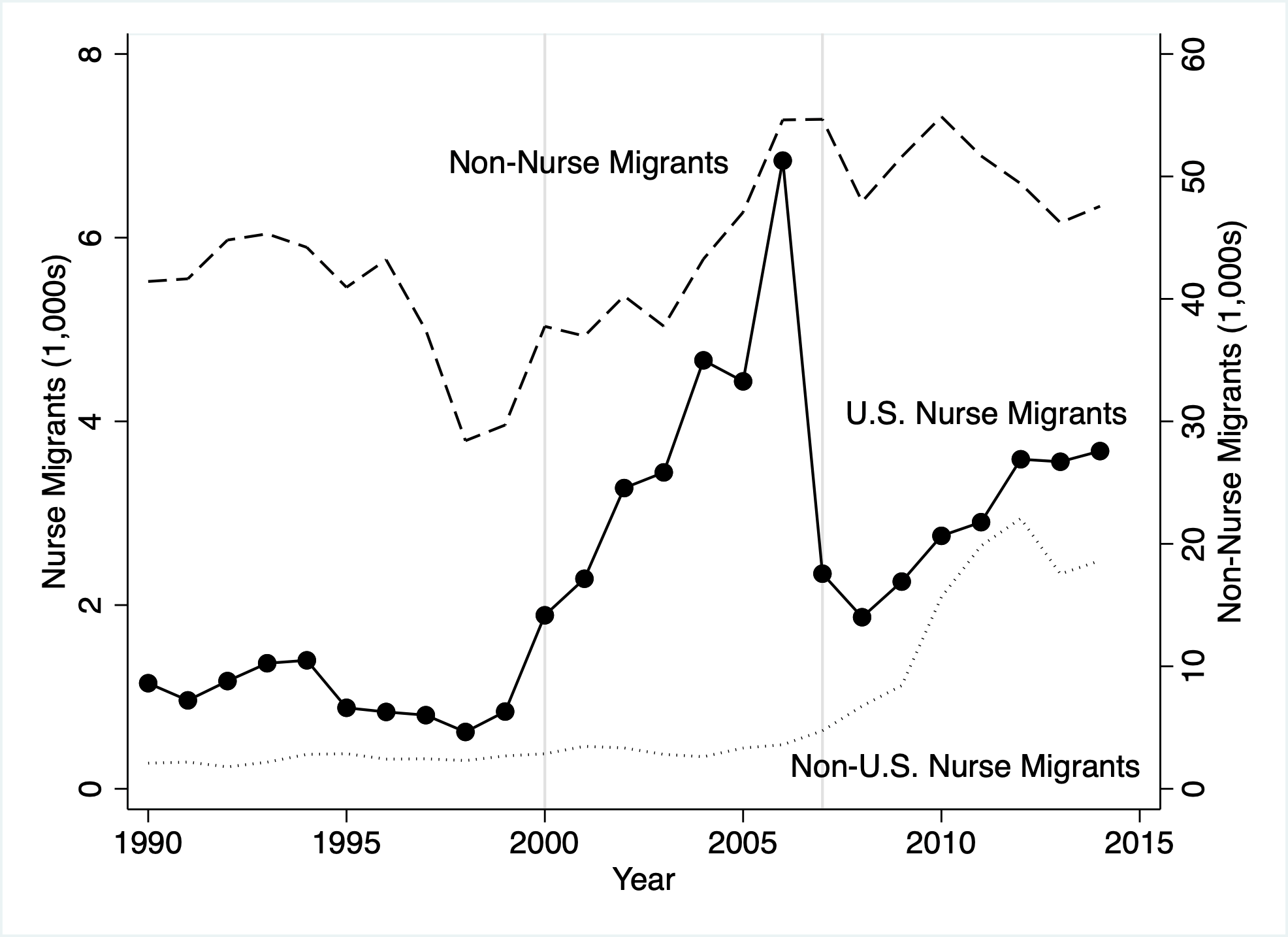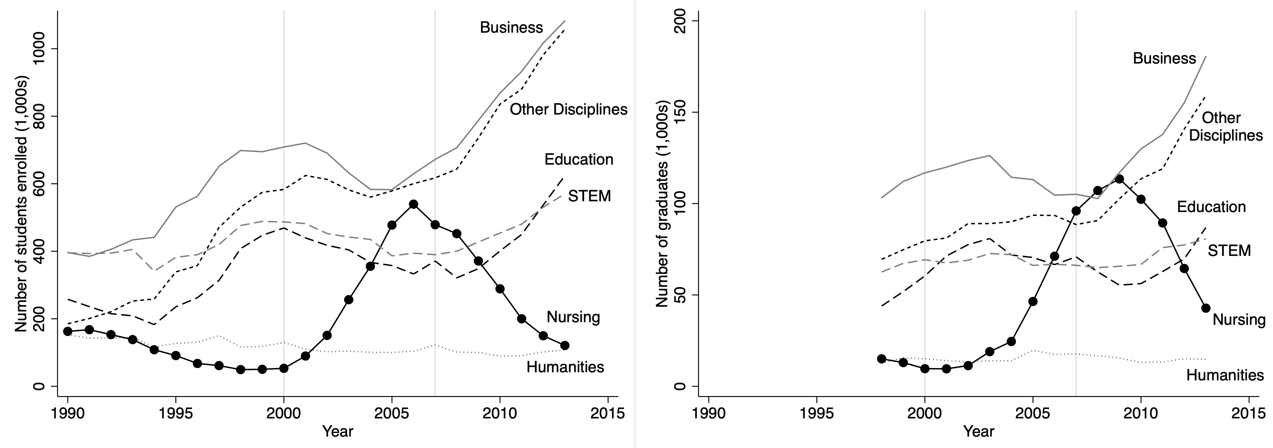
Opportunities for nurses to migrate abroad can increase the supply of educated nurses at home
Both developing and developed countries have long faced shortages of healthcare professionals, which became even more acute during the recent COVID-19 pandemic. As countries grapple with these shortages, one common response in developed countries is to recruit foreign-born medical professionals, such as nurses (Cortes and Pan 2014). While migration has many benefits for countries of origin, such as remittances and knowledge transfer (Yang 2008), many policymakers and economists have long asserted that such recruitment of skilled workers likely depletes poor countries of these workers (Bhagwati and Rodriguez 1975). Colloquially referred to as “brain drain”, many argue that this phenomenon is particularly concerning in the case of medical workers due to the potential to undermine healthcare provision in the home community.
Counter to this argument, many economists theorise that rather than brain drain, opportunities to migrate can encourage educational investment in the origin country. Since not all individuals will have the opportunity migrate, this can lead to increased levels of skill in origin countries, or “brain gain.” While previous studies have documented brain gain for primary and secondary school (for example, Shrestha, 2017), there is limited evidence on whether such brain gain is possible among highly skilled workers, particularly healthcare workers.
In recent research (Abarcar and Theoharides 2024), we examine the migration of nurses from the Philippines to inform the brain drain versus brain gain debate. The Philippines is one of the top migrant-origin countries globally and the world’s largest provider of foreign nurses. The United States is the most common destination for Filipino migrant nurses, where salaries are almost thirteen times higher than in the Philippines. This means that changes in opportunities to migrate to the US as a nurse are particularly salient for communities in the Philippines. Given these opportunities to migrate, this is a setting where the potential for brain drain could be most acute.
Filipino nurse migration
Filipino nurses most commonly enter the US market through employment-based (EB) visas. EB visas allow nurses to obtain legal status for their families in the US, making this an attractive migration opportunity. The origins of Filipino nurse migration are well-detailed by Choy (2006), and trace their routes to the US colonial period when the US established Americanised nursing schools throughout the Philippines.
Prior to 2000, approximately 1,000 to 2,000 Filipino nurses migrated to the US in each year (see Figure 1). However, in 2000, the US dramatically expanded the availability of visas for foreign nurses. We see an immediate increase in the number of nurse migrants beginning in 2000 and continuing through 2006, when nurse migration to the US peaked at almost 7,000 nurses. In 2007, the US suddenly reduced visa availability back to pre-2000 levels. These unanticipated policy changes led to a pronounced and sudden rise and fall of nurse migration to the US from the Philippines
Figure 1: Number of nurse and non-nurse migrants from the Philippines.

Note: Reproduced from Abarcar and Theoharides (2024).
At the same time, total four-year enrollment in nursing programmes rose in the Philippines from 90,000 in 2000 to over 400,000 in 2006, before declining again in 2007. The number of new nursing graduates shows a similar pattern, though with a four-year lag due to the time it takes to complete a nursing degree.
Figure 2: Post-secondary enrollment and graduation by discipline.

Note: Reproduced from Abarcar and Theoharides (2024).
Estimating the causal impact of US demand for foreign nurses
To assess the impacts of US demand for Filipino nurses on skill acquisition, we take advantage of the two sudden changes to visa policy that expanded and then restricted nurse migration to the US and compare outcomes in Philippine provinces that historically sent a large number of nurse migrants to the US to those that did not, before and after the policy changes. The intuition is that provinces with strong historical networks to the US for nurses should be more affected by the policy changes than those without these networks.
One of the difficulties of obtaining causal evidence on the brain drain versus brain gain debate is the lack of detailed data on migration and education. We use unique administrative data on all migrant departures and post-secondary institutions in the Philippines to examine impacts on post-secondary enrollment, graduation, nurse licensure exam pass rates, and the supply of nursing programmes.
Findings
Migration opportunities dramatically increased nursing school enrollment and graduation
In response to the US expansion of visas, nursing enrollment increased by 129%, relative to a pre-2000 enrollment rate of 1.35%, in high compared to low nurse migration provinces. Nursing graduates increased by 247%. New nurses switched to nursing from other fields of study, as can be seen in Figure 2. However, they graduated at higher rates than they would have in other fields of study, resulting in an overall gain in post-secondary educated labour in the Philippines.
The supply of nursing programmes expanded to accommodate increased demand
While economists have long speculated that brain gain is possible in theory, they cite the inability of the supply of education to respond as a mitigating factor (Docquier and Marfouk 2006). Crucial to the effects that we find, the supply of nursing programmes expanded by 10% per year to accommodate increased demand for education, stabilising following the reduction in nursing visas in 2007. The supply response was concentrated among private schools, largely through nursing programmes opening at existing private institutions, rather than the opening of entirely new nursing institutions. The effects on enrollment are largely driven by provinces with a large supply of existing post-secondary institutions that did not already have a nursing programme.
More individuals pass the nursing licensure exam
Not all new graduates induced by the visa expansion eventually passed the licensure exam. Exam pass rates declined from 58% in the pre-visa expansion period to 38% in the post-visa expansion period. Despite these lower pass rates, so many new individuals took the exam in response to increased opportunities for migration that for each new nurse that moved abroad, nine additional nurses were licensed in the Philippines. This suggests a substantial brain gain of nurses in the Philippines.
Brain gain, not brain drain
Our research provides evidence against the idea that skilled migration necessarily depletes origin countries of health professionals or college graduates more broadly. In fact, for the Philippines, nurse migration to the US increased both the supply of nurses and the supply of college-educated labour in the Philippines. The number of individuals working as nurses in the Philippines also increased. However, it is also worth noting that this did not fully address healthcare workforce shortages. Anecdotal evidence suggests that in the period we studied, many individuals trained as nurses who did not migrate pursued careers in business process outsourcing and call centers, where a college degree is often a prerequisite and compensation tends to be higher than in nursing (Marcus et al. 2014).
For policymakers, the implications of our research are twofold. First, the ability of the supply of schooling to respond to increased demand is crucial for the brain gain effects we find. Such a response may not be possible in all contexts, for example in sub-Saharan Africa, where the post-secondary education system may not expand as readily in response to increased demand. Second, with the right policies and institutions, skilled migration can address the shortage of healthcare workers in developed countries such as the US while also bolstering human capital in the countries from which migrants originate. Such policies should also focus on the range of issues which constrain the ability of the origin country to recruit and retain existing workers. This includes improving renumeration, working conditions, and career prospects (Philippine Institute on Labor Studies 2021). Taken together, our research highlights the potential for and importance of well-designed partnerships between destination and origin countries (Clemens 2015).
References
Abarcar, P and C Theoharides (2024), "Medical Worker Migration and Origin-Country Human Capital: Evidence from U.S. Visa Policy", Review of Economics and Statistics, 106(1): 20-25.
Bhagwati, J and C Rodriguez (1975), "Welfare-Theoretical Analyses of the Brain Drain", Journal of Development Economics, 2(3): 195-221.
Choy, C C (2006), Empire of Care: Nursing and Migration in Filipino American History, Duke University Press.
Clemens, M (2015), "Global Skill Partnerships: A Proposal for Technical Training in a Mobile World", IZA Journal of Labor Policy, 4(1): 1-18.
Cortes, P and J Pan (2014), "Foreign Nurse Importation and the Supply of Native Nurses", Journal of Health Economics, 37: 164-180.
Docquier, F and A Marfouk (2006), "International Migration by Educational Attainment (1990-2000)—Release 1.1" in International Migration, Remittances and Development, ed. C Özden and M Schiff, Palgrave Macmillan: New York.
Marcus, K, G Quimson, and S Short (2014), "Source Country Perceptions, Experiences, and Recommendations Regarding Health Workforce Migration: A Case Study from the Philippines", Human Resources for Health, 12:62. https://doi.org/10.1186/1478-4491-12-62
Philippine Institute for Labor Studies (2021), "Study on the Filipino Health Workforce: A Sequential Exploratory Analysis of the Decent Work Indicators in the Health Sector", Research Brief, December.
Shrestha, S A (2017), "No Man Left Behind: Effects of Emigration Prospects on Educational and Labor Outcomes of Non-migrants", Economic Journal, 127(600): 495-521.
Yang, D (2008), "International Migration, Remittances, and Household Investment: Evidence from Philippine Migrants’ Exchange Rate Shocks", Economic Journal, 118: 591-630.


